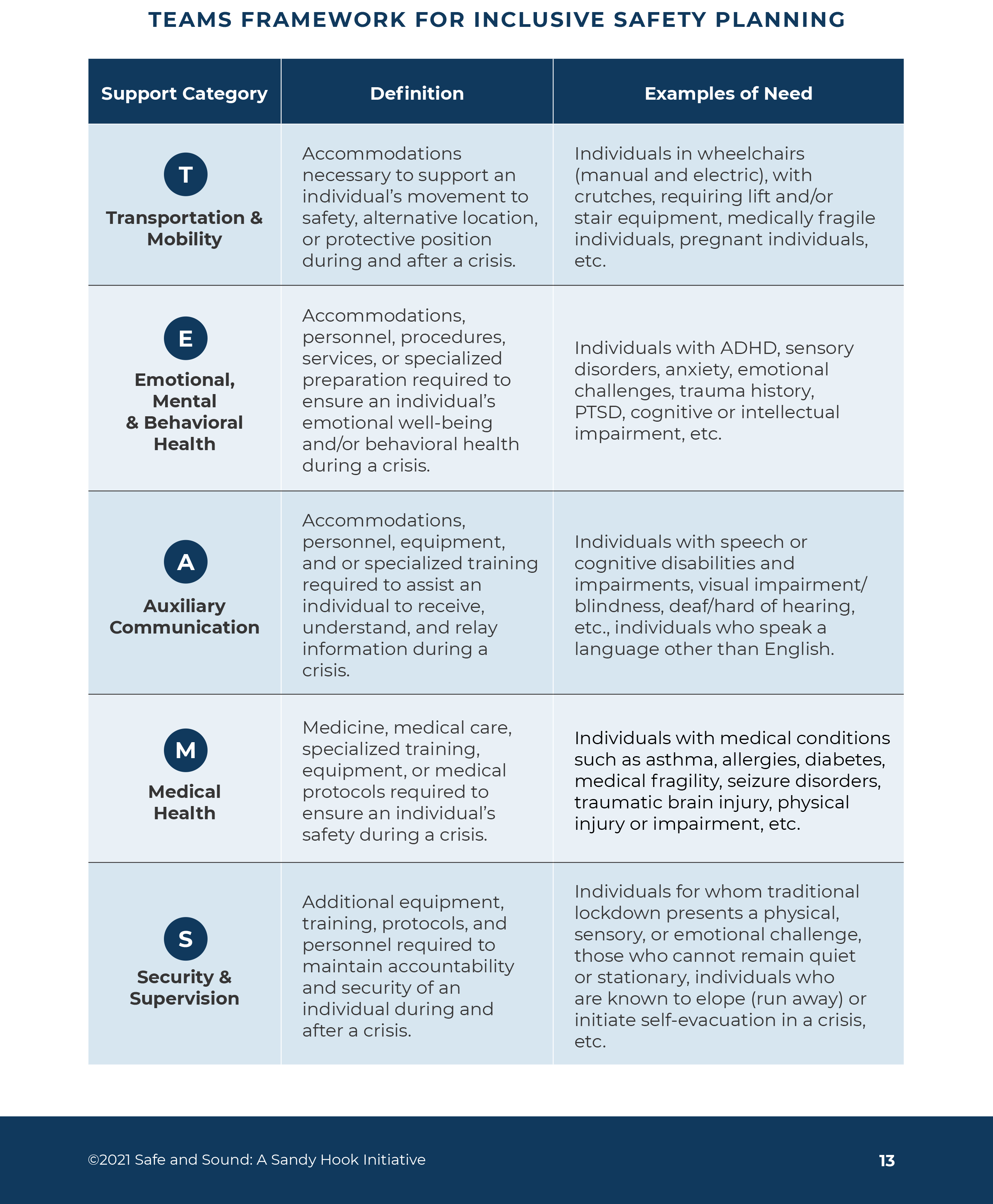

Students, staff and visitors with disabilities are often overlooked in traditional school safety and security plans. According to the National Center for Education Statistics, roughly 7.3 million students receive special education services. Developmental disabilities, mobility and communication challenges, medical needs and more pose unique opportunities for inclusion in creating a holistic security plan. A recent webinar featuring Michele Gay from Safe and Sound Schools and Paul Timm PSP, explored the topic of promoting physical safety and security planning in schools, particularly for students with disabilities. One highlight was the inclusion of the TEAMS framework in the planning process.
The TEAMS Framework
It takes more than just a team to develop an inclusive safety plan to meet the needs of each individual—it takes careful planning, education and preparation. The TEAMS framework serves as a guideline of recommendations for inclusive safety planning. Each letter in TEAMS—Transportation and Mobility, Emotional, Mental & Behavioral Health, Auxiliary Communication, Medical Health, and Security and Supervision—represents a category of support to consider.

The S in TEAMS: Security and Supervision
Assessing Security Needs for Students with Disabilities
The first step in creating an inclusive safety and security plan is to assess the needs of each individual with disabilities. Because disabilities can be unique, safety plans must also be personalized to their unique needs and ability. By identifying those who may have difficulty with traditional lockdown procedures, and evaluating the physical, sensory, and emotional challenges of each person, the team can begin to craft individual safety plans (ISP) to accommodate those needs.
Specialized Security Equipment and Accommodations
In many cases, students and staff with disabilities may also need specialized equipment and accommodations included in their security plan. This may include assistive technology and mobility aids, sensory supports (e.g., noise-cancelling headphones), weighted blankets or fidgets, and personal safety devices, including GPS trackers or alert systems. Whatever is chosen, it’s important that the individual with the disability is included in making the decision, and staff are trained in operating any equipment that requires assistance, especially in emergency or high-stress situations.
Training for Dedicated Security Personnel
Staff must be equipped to support students, other staff members or visitors with disabilities, including sensory, emotional, cognitive or behavioral challenges in times of emergency. This goes beyond just learning how to use specialized equipment—they should be well versed in understanding each unique ability of the individual, the specialized protocols for assisting during emergencies, and providing support during and after crisis.
Paraprofessionals or classroom aides assigned to provide 1-on-1 support can be extremely valuable members of a student’s security planning team. They relieve the teacher from some of the daily safety protocols and can provide specialized attention and immediate assistance in emergencies. Of course, the ability to provide 1-on-1 support depends on the staff availability and each student's needs. Students with disabilities who may not need as much specialized support from daily 1-on-1 attention can still benefit from having a paraprofessional or classroom aide present and ready to assist them in emergencies.
Securing the Evacuation Process
Evacuation in emergencies can be stressful for anyone, regardless of their abilities. Remembering where to go, which stairwell to use, or what designated location to meet in once evacuated can be difficult during high-stress situations. People with disabilities may need to take extra steps or precautions during evacuation. Tailored evacuation plans should be created and practiced regularly to ensure both staff members and students understand the protocol. Those requiring mobility aids during evacuation should coordinate and ensure adherence to exit protocols to avoid being stranded or faced with an emergency exit they cannot successfully navigate.
Key Takeaways
Inclusive school security is essential for students, staff and visitors with disabilities. The TEAMS framework provides clear guidelines for creating a holistic security plan that addresses the unique needs of each student. The "S" in TEAMS, which stands for Security and Supervision, emphasizes the importance of assessing the security needs of individuals in schools with disabilities and providing specialized equipment and accommodations. Students and their parents or caregivers should always be included in creating their individual safety plan and be allowed to make choices that work best for them. Additionally, be sure to connect with disability advocates and emergency responders in creating or updating your school’s emergency plans to be more inclusive and address the needs and abilities of everyone.
For a broader discussion on school security for students, staff and visitors with disabilities, and more information on the TEAMS framework, watch the webinar featuring Michele Gay and Paul Timm, PSP.